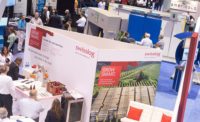Logistic Solutions: Cold Calculations

Refrigeration control experts sound off on warehouse energy savings strategies, technologies.
Editor’s note: To learn about the latest warehouse refrigeration control technologies, Refrigerated & Frozen Foods approached several industry suppliers. Following is a discussion with Dan Black, president, Techni-Systems LLC, Chelan, Wash.; Matt Chang, vice president of marketing, Hench Control Inc., Hercules, Calif.; Jim Conant, president, Logix, Kirkland, Wash.; and Michael Keller, Control Products division manager, Doubl-Kold, Yakima, Wash.
Refrigerated & Frozen Foods: How has increased interest in energy savings affected the refrigeration controls sector?
Matt Chang: After the world finally turned its attention to global warming, the primary driver that influenced our market to make a change was the economic impact of the inevitable rising cost of energy. In the past, energy price subsidies from utility companies provided a stop-gap cost control in some regions, which fooled businesses into thinking that energy prices were less than they really were. These subsidies are now disappearing and prices are moving back toward market rate where the true cost of energy is forcing our industry to react accordingly.
Never have energy prices been as high as they are today and that trend illustrates that the cost of energy will continue to rise for the foreseeable future. According to the Energy Information Administration, electricity demand is projected to increase up to 17 percent by 2014 and today it is over two times the cost it was only five years ago. Electricity costs for cold storage and food processing facilities in the U.S. alone are over $3 billion per year.
Another significant market driver that emerged in 2007 involved sustainability initiatives. More cold storage operators and food processors are becoming environmentally conscientious. A closer look at this issue suggests that 70 percent of the U.S. power grid is made up of carbon producing facilities and for every kilowatt of energy nearly two pounds of CO2 are produced. On average a 2,000-horse power facility is responsible for 20 million pounds of CO2 per year.
Jim Conant: Customers are looking to us to make their operations more efficient without sacrificing quality. Energy conservation is so prevalent that many local utility companies are funding the purchase cost of control systems, and customers are reaping the benefits. With the local power company footing the bill, the market for our product has significantly increased.
At the same time, many companies have been forced to be more energy conscious, simply to remain competitive. We have seen a steady increase in control system retrofits as short payback periods for such projects have repeatedly been proven throughout our customer base. Owners have placed energy efficiency among their highest goals and consider it integral to successful facility ownership.
Michael Keller: Earlier, there was no incentive for the customers to upgrade their older equipment because there was no data showing the customer the savings or payback they would receive. Energy studies abounded last year. With these, we were able to get into many niche markets and facilities that we were not able to reach before.
I’ll note that as an industrial refrigeration and industrial controls integrator, we work with customers and [third-party] energy engineers to provide optimum control and refrigeration options for energy savings. Often, we find cases where a customer will want to run a variable frequency drive fan at 100-percent fan speed whereas an energy engineer would love to see it running at 40-percent speed. We have to take a middle road and develop technologies that will work for a whole range of requirements and configurations. Then, we step back and let the engineers work with the customer on how to get the best efficiency out of their facility - without harming the customers’ product or production.
R&FF: What else are food processors and cold storage operators asking for?
Dan Black: It has been an evolutionary process over the years. The biggest changes have originated with energy conservation programs. We have integrated many customer suggestions into our systems.
Chang: We continually hear that facilities need systems that are compatible with existing set-ups. The beautiful thing about our technology is that it runs through - or along with - any pre-existing system. This makes the integration completely seamless.
A major complaint we hear is operators want to know exactly what is wrong when they receive an alarm, and most systems do not specify. Rather, most technologies send a blanket alarm that requires the operator to do some detective work throughout the entire plant to discover what the issue is. Because our system is modular in design, the controllers are able to distinguish specifically what this issue is and where it is. Our system contacts the operator and directs them about where to go to resolve the problem.
Most facilities also have one main operator who knows the plant intimately and [who] is physically needed at the plant to perform any changes. Ideally, this operator would be able to check-in to view the status of the plant at any time remotely and make any necessary changes without having to be in the facility at all times. We believe that we’ve solved this problem for the operator through a personal digital assistant [a new offering that provides remote access].
Lastly, every food processor we speak with tells us that they cannot find a system that manages blast freezers. We developed a blast freezer controller that uses an intermittent cooling technique we developed 20 years ago to save energy. This technique allows the controller to start and stop the fans in a blast freezer on the basis of the mass being cooled, such that the total cooling time is not affected. For example, it saves energy by not running the fans continuously in the final portion of the blast cycle. Thermodynamics plays a huge part in this process.
Conant: Reliable, safe energy conservation strategies are very important to maintain product quality. As a result, we are seeing a large increase in energy monitoring. Customers want to see where their energy dollars are being spent and they’re asking for advanced temperature control strategies that conserve as much energy as possible. There have been increased numbers [of companies involved] in load shifting due to peak and off-peak electrical demands.
Room air averaging also has been on the rise to maintain a uniform temperature throughout the refrigerated area, while keeping energy consumption at a minimum. By using electrical metering devices, customers can make informed changes in operations to make their facilities more energy efficient. They get instant energy consumption data that tells them how well the operational changes are working.
Keller: Many of our customers are asking for wireless connectivity around their plants with mobile human-machine interface (HMI) technologies that would allow them to do their work - or troubleshoot their facility - from anywhere.
Another [area of operator concern] involves efficient plant energy cycling. It’s simply not enough to shut the plant off at peak hours, when product is involved. Operators would like the software to intelligently shut off areas of their system, and not endanger the integrity of the product. Because there are occasional changes involving the status of what can be shut off and why - the operator ultimately needs to have the ability to change the parameters to suit their situation.
R&FF: Can you tell us about other news, new products or product improvements at your company?
Black: We have been designing and installing computer-based control systems for 21 years. We have continually improved our products and our most recent changes have largely involved subtle refinements. A few years ago, for example, we started integrating video surveillance features into our systems for customers concerned about theft and safety.
Chang: Last year was a momentous one for Hench, as the company changed ownership. Our new management team has restructured the business strategy and model.
As I mentioned earlier, Hench’s newest product provides remote access to our energy management system for maintenance managers and facility operators. Facility operators continually are frustrated by receiving vague system alarms and always having to be tied down to the site at all times. Our new Hench Personal Digital Assistant (HPDA) software enables an operator to be off-site, check the status of the refrigeration equipment and make changes if necessary at any time, remotely.
I’ll note that an international, multi-billion dollar food processor recently named Hench as one its “best practices” suppliers, for helping that processor save as much as 35 percent off its energy bills.
Conant: System integration has always been a key element when it comes to making a facility more energy efficient. We look at the entire refrigeration system and determine the most efficient combination of equipment to meet the facility’s needs. Our sophisticated demand-limiting and load-shifting strategies can dramatically reduce energy costs while maintaining product quality and integrity. Real-time energy cost information (via the Internet) allows for rapid reaction to variable energy cost utilities.
Keller: We are a computer control company that runs on Microsoft.Net technologies, so things tend to change rather quickly. Vista OS was released last year and caused a commotion in the software industry but our new Version 2.0 system is completely Vista compatible.
Our control system uses a split-system strategy - one HMI computer (or more) that communicates with one or more controllers also running the Windows OS. In our newest offerings, we are working hard to make the controller / HMI system into more of a mesh network. We also will be striving for better graphics with more customization, improved graphing abilities and more tools built into the system that help the user schedule tasks and reduce the amount of paper work currently done in the industry.
This is not to say we don’t work with smaller systems. We now have a light version of our main system that only does monitoring, with a few tools including our standard graphing package.
With programmable logic controllers (PLCs), we tend to use only items with the simplest of logic, such as ammonia sequencers, and other small niches. As a company we don’t feel PLCs offer the flexibility that a PC can offer, or the long-term stability. So we tend to limit their use.
R&FF: How might refrigeration controls change most by 2010?
Black: Refrigeration control technology has matured during the last 20 years. Future changes are likely to be small - but involve complex refinements. However, as computing technology advances, there will be many enhancements in user interface and information management. It is possible that the refrigeration controls will be integrated into a larger facility-wide system.
Chang: We see refrigeration controls becoming smarter, with fewer moving parts. As technological advances continue to evolve, refrigeration controls will integrate best practices to enhance and replace existing hardware and software.
We are continuing to invest into research and development. We have identified opportunities and are proceeding with new products and features on our build-out project list for 2008 - with some projects earmarked as far out as 2012.
Conant: As controls systems become more sophisticated to take advantage of energy savings, they also must be user-friendly so that the typical operator can readily apply this technology effectively.
At the same time, rapid adaptation to variable energy cost and rate structures will require a very sophisticated approach to energy management. We believe our expertise and control technologies are prepared to meet the need. In addition, we anticipate a growing trend toward “operator-less” facilities, and Logix is at the ready with our ability to provide remote access and notification.
Keller: We believe in 2010 energy-saving technology will stabilize, and energy efficiency will be the driving force of the industry. Lack of knowledge about energy-saving strategies will no longer keep businesses from finding and implementing the equipment or tools needed to get their facility on track. There will be a move to more efficient control algorithms designed by a joint effort in the industry and a more open approach to the problems of energy efficient control.
Some of the next big hurdles may be making vast separate systems work together, and unifying communication packages (hardware and software). There are so many different flavors of communication and, unfortunately, most of them were developed decades ago, when communication times were slow and limited and some were developed to lock customers into one type of control product. Even the most limited PIC controller today has vastly more sophisticated means of communication parsing.
We always are looking into the future of what may be just around the corner. Our developer Matt McGuire has some interesting ideas for the future, including limited artificial intelligence, mesh networks, energy shedding, mobile HMIs, embedded systems, communication protocols, voice control, and new flexible control algorithms, to name a few.
Looking for a reprint of this article?
From high-res PDFs to custom plaques, order your copy today!








